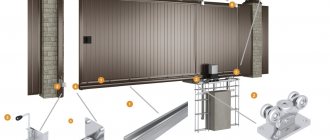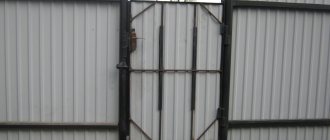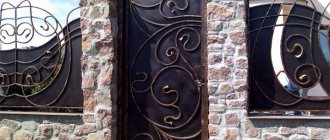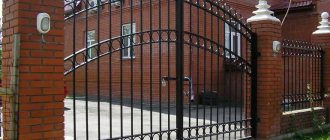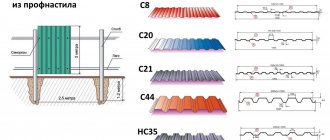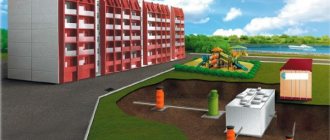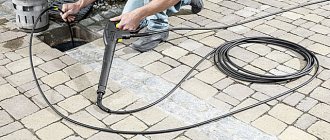Anyone who knows how to understand sketches and drawings and also has the necessary set of tools can build sliding gates with their own hands. With a certain amount of effort, you can get a decent result that will look and work no worse than structures made by professionals. Sliding gates are a popular option for cottages, private houses and parking lots. They are practical and durable. This design does not require special care and maintenance. In addition, it can be supplemented with automation yourself.
Types of sliding structures
There are several types of gates, each of which has its own pros and cons. Therefore, before answering the question of how to make sliding gates with your own hands, you need to study all the varieties.
Hanging gates
Previously, such structures were found at the entrance to the territory of enterprises and other protected objects. A metal beam was installed at a great distance from the ground, exceeding the height of the freight transport. Subsequently, the door leaf was hung on it using roller trolleys.
These gates are quite reliable. They are over 50 years old, but still work, although they are rarely used today. And there are several reasons for this:
- limited height passage;
- increased metal consumption. If in Soviet times metal prices were more than affordable, then in modern realities, installing hanging gates requires a significant investment.
If the suspended structure has aroused interest, then on the Internet you can find a video on how to make sliding gates of a similar design with your own hands.
Sliding on rail
These gates have a simple design and assembly pattern. They are compact - when opened, the sash takes up space equal to the width of the passage. Rail gates can cover large openings (up to 6 meters), and the gate does not sag.
The gate leaf, standing on rollers, rides on a rail laid across the road. The sash is held on top by a bracket with rollers. It turns out that the canvas rolls in the passage, like a carriage on railway tracks. These sliding gates can be made with your own hands and at the same time cheap. The only drawback of this model is the need to regularly clean the rail from debris, sand, snow and other obstacles that impede the normal movement of the sash.
Important! Rail gates are not designed to operate in “strong” wind and snowfall, therefore they are used mainly in European countries.
Console
In order to eliminate travel height restrictions and prevent contact with the ground rail, cantilever gates were invented. They are the most difficult to implement, but it is this modification that is most suitable for the Russian climate. Therefore, later in the article we will provide a detailed plan and drawings on the topic: how to make cantilever sliding gates with your own hands.
The fabric of this design does not contact the surface. It hangs over the passage. The sash itself is attached to a supporting beam, which is fixed to the foundation using roller carts. Depending on the location of the guide beam, cantilever gates are divided into sliding structures with an upper, middle and lower location of the supporting beam.
The first two options are justified when it is possible to hang cantilever units on the main wall of the building or there are any structures and structures that can withstand the load from the gate. In the absence of the above, you will have to pore over the construction of a special power structure, which is not always profitable.
Types of structures
There are many types of gates, which can be made of different materials and equipped with special mechanisms. A wide selection allows you to create homemade gates based on the characteristics of the room or area, your needs and frequency of use.
Before making gates, you should study the main types of designs that are popular.
Sliding
Sliding canvases are divided into several categories. Depending on your preferences, you can choose the option you need. For each type of structure, you will need to clear a free area along the fence so that the sash can open freely.
There are cantilever sliding structures , hanging and sliding ones. The structure of such canvases involves moving along rails and other metal profiles.
Suspended options are not popular for use on private property, since the ride height is limited by the upper profile to which the canvas is fixed. The valves also move along this profile.
Some owners of country houses install fan structures , which received this name due to their appearance.
Sliding canvases , which move along a rail located along the wall, are also not popular in snowy and northern cities.
In order for the sash of sliding structures to move freely along the rail, it will be necessary to constantly remove ice and other debris, which is not always comfortable in winter.
Cantilever leaves are considered the most optimal design for sliding gates. The canvas is rigidly attached to the beam, which moves along the cantilever assembly and moves the sashes behind it. Despite the fact that the structure of the products is complex, they work perfectly in the winter season, since the sash does not come into contact with the ground .
Tilt&Turn
This design is optimal for garage conditions. They are not suitable for installation in the yard, since the gates limit the entry height. The canvas should function freely by lifting and sliding the sash under the ceiling of the room.
Swing
Such structures with a door are often installed on the fence in the private sector. Swing gates are based on pillars, two of which are located at the width of the door leaf, and the third pillar is located next to the gate, if it is located next to the structure.
Rolled
These designs have recently appeared on the market. Gates are made of steel strips, which are combined into a flexible sheet. When it is necessary to open the gate, they begin to roll up and wrap around the shaft. This solution allows you to drive close to the room.
Folding
Folding gates are known to many as “accordion gates”. The door can be opened upwards and sideways. There are sealing gaskets between the metal mesh. Designs that open upward have become widespread.
Advantages of cantilever gates
It is not surprising that many people are looking for drawings and diagrams in order to make sliding gates with their own hands, because these designs have a lot of advantages.
- This design does not have opening doors, which means it saves usable area. In addition, if the gate is accidentally opened, there is no risk of damage to vehicles standing in front of it.
- The passage is not limited in height.
- Heavy snowfalls do not affect the functionality of cantilever structures, since the canvas hangs at a distance of approximately 10 cm above the ground surface.
- All elements responsible for the operation of the structure are located inside the beam. This protects them from the influence of weather factors. Even a child can make the gate work, thanks to the modern design and low friction.
- A solid foundation and a well-thought-out system for holding the leaf in a vertical position make the gate resistant to strong wind loads.
- Cantilever gates can be easily equipped with automation and other security elements.
Like any other gate, cantilever gates also have disadvantages, but there are not many of them.
- The presence of a complex structure, due to which installation causes certain difficulties.
- Installation requires a free section of fencing 1.5 times larger than the driveway, which is not always achievable.
Gate calculation features
Features of independent calculation
Design calculation is one of the most important and priority stages. You should not ignore this stage, since the construction of sliding ones is much more complicated than swing ones.
The calculation process includes the following steps:
- Determining the height and width of the opening. As a result, it will be possible to select the required type of gate for free movement.
- Counterweight calculation.
- Estimation of the weight of the structure being constructed.
- Making a sketch or drawing.
The calculation of the width and height of the structure should be based on the market range. So, if a profile or pipe can be easily welded, then cutting sheets of corrugated board for the purpose of adding it is very difficult. Plus, the result will be unaesthetic.
Sliding gate calculations
Moreover, understanding the final weight of the structure, appropriate mechanisms and moving parts are selected that can cope with the load.
If the canvas is supposed to be large, then be sure to take into account the wind load. Add a small margin to the existing wind force prevailing in your area.
Although the easiest option for obtaining calculations is to contact a specialized company that will provide a folder with drawings and calculations, you can do this yourself. It is worth immediately noting that all of the above calculations apply to cantilever-type sliding gates. They are more complex than all other types, so let’s look at them in more detail.
Opening height and width data
The gate width (L) will be equal to:
- opening width;
- technological opening/closing intervals;
- minimum distance between the centers of the carriages.
Based on this, L will be larger than the opening.
Counterweight calculation
When moving, the doors must be balanced. This indicator is achieved by calculating the counterweight. Thanks to this, the specific gravity of the structure will be evenly distributed over the carriages. Accordingly, in order to have as little load as possible, the counterweight must be large.
But what if there is not enough space for the sash to move? In this case, it is necessary to understand that the length of the counterweight should not be less than 40% of the width of the sash. The ideal figure is 50%. As a consequence, the width L has a counterweight in its design.
Having such calculations, you can determine how much space is needed to roll back the gate along the fence.
Weight calculation
This value is determined based on the weight of the material used:
- Corrugated sheeting ~ equal to 4 kg/m2.
- Steel, thickness 2 mm ~ 17 kg/m2.
A gate with a 4x2 m frame will weigh on average 200 kg. Having such data, it is possible to determine the indicators of the guide beam. In this case, you can build on the established standard.
For a gate weighing 300 kg, a 9x5 cm beam with a thickness of at least 3.5 mm is sufficient. However, a safety margin of up to 40% is required. It will significantly simplify the operation of the gate and increase its service life.
Calculation of the strength of fittings
The gate will require rollers, catchers and a support rail. Modern products of this type allow you to choose the desired design. As a basis, we will take the simplest estimate of the wind load, which is equal to 12 m/s to 90 kg/m2 and is evenly distributed over the support zones of the canvas.
How can you make sure that the structure you have made will work without interruption even in strong winds? To do this, it is necessary to ensure that the strength of the fittings is greater than the calculated weight of the gate. A lateral moment of 100 kg/m is also taken into account, multiplied by 8 kg/m, which equals 800 kg/m. In principle, this is not much ~ 150–180 kg/m for each supporting element.
When buying a roller mechanism, make sure that it has a margin of up to 30% in relation to the weight of the gate. But this indicator does not affect the service life in any way. This is directly affected by increasing the distance between the centers of the carriages.
Additional calculations
In addition to all of the above, it is worth paying attention to other aspects. Pay attention to the gate rail, supports for roller carriages and the number of anchors. It is also important to correctly calculate the mortgages on the support pillars. In this case, it is necessary to start from 60% of the total mass of the gate, divided by the number of mortgages.
As for the calculation of the foundation, there are no special secrets here. But despite this, you should not lose sight of this component, because often the cost of the foundation reaches 40% of the total cost of the project.
Construction device. Essential elements
For those who are interested in drawings of sliding gates and installing the structure with their own hands, below is a diagram with the lower location of the console.
The canvas is attached to a metal frame (1) made of a profile pipe. A guide beam (2) with a special profile is welded to it, inside which roller carriages (3) are located. In this case, the beam moves together with the canvas left and right along the carriages, closing and opening the gate. The main load is borne by the beam and roller system, especially when closing and fully opening the sash. In order to reduce the load when completely closed, an end unloading roller (4) is provided, which enters and rests against the lower catcher (5). On the other side of the gate, when fully opened, the gate is secured by a removable roller with a catch stop, but it is not shown in this figure.
Watching a video on how to make sliding gates with your own hands, you can see how craftsmen solve the problem of lateral motion sickness. To deprive the gate of this dynamics, a guide with rollers (7) and an upper catcher (6) are installed, which reduces the windage of the gate when closed. The supporting beam is equipped with plugs (8) that protect it from foreign objects and dirt getting inside. For the installation of the entire structure, three power elements are provided: support (9) and counter (10) pillars, as well as a foundation (11). If there are fairly strong columns on the territory (made of brick, concrete or metal), then they can be used as gate supports. If there are none, then they will have to be erected separately from a profile metal pipe. In any case, the base for sliding gates will have to be equipped separately.
The console design is easily equipped with automation. The electric drive is usually installed between roller carriages (trolleys). To set the sash in motion, a toothed rack is attached to the side. The drive is equipped with a control unit and other devices responsible for safety.
What are roller doors made of?
- Foundation. It is poured next to the main support column (2). A channel or corner (14) is concreted on top of the foundation;
- Main support pillar. Can be brick or metal;
- Reception post;
- Beam (guide) - it bears the entire load;
- Gate leaf. Welded from a metal profile. 60x40 for wood and 50x50 for corrugated sheets;
- Stiffening rib. Profile pipe 20x40. The casing is attached to it;
- Rollers on which the beam rolls. Attached to the foundation, on the channel;
- Bracket with guide rollers to eliminate lateral swings of the structure;
- Bottom catcher (trap). Attached to the receiving pole;
- Upper catcher that fixes the canvas in the closed state;
- Lower unloading roller at the end of the beam. To reduce the load in the closed position of the gate;
- Guide beam plugs to prevent dirt from getting inside the beam;
- Automatic drive. Welded into the channel;
- Twenty-centimeter channel or corner.
When can sliding gates be installed?
To install sliding gates with your own hands, sometimes a budget, step-by-step instructions and a great desire are not enough. After all, the success of installation mainly depends on the capabilities of the site.
- The space along the barriers where the sash will move must be free by at least 1.5 times the width of the passage. This is a mandatory condition, since this section, according to the plan, accommodates not only the canvas covering the opening, but also the technological part, the length of which is 50% of the width of the opening (no less). It is this value that allows you to best distribute the load from the gate onto the cantilever block.
- The sliding structure moves in a straight line, therefore, the free space along the fence must be straight.
- In the area where the gate will be located, the terrain must be smooth; any flaws that could interfere with the free movement of the canvas are unacceptable.
- It is better to place gates on the opposite side of the gate movement path. Sometimes site owners ask for the installation of sliding gates with built-in gates or build such a structure with their own hands. This option is extremely inconvenient for children and the elderly due to the presence of high thresholds.
- Often, owners plan to use the gate as a gate. It is understood that the sash will move to a specially specified distance, convenient for a person. This should not be done for one simple reason: any mechanism is designed for a certain frequency of use. And if you use it more often, it will negatively affect the resource.
- If the entrance to the site is carried out from a narrow alley, then to facilitate maneuvering it is necessary to increase the opening of the structure, and with it the size of the road surface.
If the site has nothing in common with the above, then you can safely begin arranging the sliding gates with your own hands in accordance with the photo.
Preparation for welding work
Making fence and garage doors with your own hands is carried out in stages. They start with preparatory operations.
Selection of design and dimensions
The type of gate depends on the availability of free space:
- If there is a lot of it, a single-leaf structure is built. If there is a concrete coating, the free end of the blade can be installed on a roller. This will relieve the support column.
- If there is little space, choose double-leaf gates. This option is the most popular.
- In cramped conditions, sliding (or sliding) gates are built.
Drawing with gate dimensions
The latter option is also preferable if it is decided to equip the product with a drive for automatic opening. This is convenient because the driver does not have to leave the car in bad weather.
The width of the gate is taken to be 3 m. If entry is expected at an angle, this parameter is increased to 3.6 m.
A 2.5 m wide structure is installed in a garage for a passenger car.
The choice of leaf size for double-leaf gates depends on the method of closing them. If both parts are connected end-to-end (fence structure), they are made equal in width. Garage doors are made so that one leaf overlaps the other. For this purpose it is made wider.
We recommend reading: Welding a sauna stove yourself at home
Drawing up a drawing
To determine the exact dimensions of all components, the product is drawn on paper to scale.
The following are taken into account:
- The hinges are welded to the support posts through 4 mm thick plates. This connection will be more durable.
- The gap between the doors and the posts in the closed position is 10 mm.
It is convenient to draw the product on graph paper. If you have PC skills, it is advisable to master one of the computer-aided design systems, for example AutoCAD or Solid Works. These programs allow you to create 3D models of doors with bolts and assemble them into a single structure. The user will be able to view the gate from different angles and check its functionality. The system will warn you if parts intersect when closing and will automatically create drawings. All that remains is to measure them.
Selection of base material
Rolled steel with a wall thickness of at least 2 mm is used. For blind cladding, choose a sheet of such a size that it turns out solid.
Calculation of metal costs for manufacturing
Based on the drawings, a specification is drawn up, i.e. a list of all necessary parts and preparations. Using this document, the length of the profiled pipe, angle and sheet material is calculated, and a margin of 10% is added.
In addition, the number of hinges, locks, fittings and other finished products is determined.
Accessories
A general statement is needed in order to purchase everything you need in one go.
This will allow you to get a good discount and save time, as well as shipping costs.
How to calculate the optimal opening width?
When drawing up a project for installing sliding gates with your own hands, you need to answer the most important question: how to calculate the width of the opening? In this context, the width of the gate will mean the width of the leaf, i.e. free space between the power elements when the gate is fully open. To answer this question you need to clarify a couple of points.
- What vehicles will enter through this gate?
- At what angle will vehicles (especially freight) enter?
Based on practice, sliding gates should have such a width that when crossing them, a gap of at least 30-50 cm is maintained between the supporting pillars and mirrors on each side.
The entry angle of trucks is 45 degrees relative to the goal line. Those. In order for a KamAZ truck with a width of 2.9 meters to drive onto the site at an angle of 45 degrees without taking into account the gap, it turns out that the width of the opening should be 4.1 meters. However, these data cannot be relied upon. Firstly, because the gap was not taken into account, and secondly, it happens that a car passing through the gate may, for one reason or another, sway or slide to the side due to ice, etc. Taking all this into account, experts recommend making homemade sliding gates with an opening width of at least 4.5 meters (ideally 5 meters).
All of the above related to the width of the opening of the structure. If we talk about the width of the sash, then it should be 20 cm larger. If this condition is neglected, then a gap will be visible when the gate is closed. In the case where the finished canvas is the same width as the opening, you can try to correct the situation by moving the gate posts a little closer to each other than originally planned. The width of the opening will decrease by 15-20 cm, but a gap will not appear.
Necessary tools for work
Tools for installing sliding gates
Almost everyone involved in construction work has tools for the manufacture and installation of metal structures; otherwise, they rent them.
Tool kit:
- crowbar, bayonet and shovel shovels, trowels, buckets, stretchers;
- grinder with a steel circle and a cleaning disc;
- concrete mixer;
- welding and consumables;
- screwdriver, drill;
- step ladder;
- level, plumb line, construction square, tape measure from 5 m;
- hammer, pliers, core.
An entrenching tool is needed to prepare a hole for a foundation and a trench for laying electrical wiring. They pour cement, sand and crushed stone into a concrete mixer.
In each specific case, the list of devices can be increased. For example, if there are roots of bushes or trees in the ground, you will additionally need an ax.
How high should the gate be?
Many will decide that this point does not deserve close attention and discussion. Indeed, in some videos, and even in the instructions for installing sliding gates, this is not mentioned. This is partly true. After all, if you don’t understand this issue, then this will not create any significant problems, except perhaps aesthetic ones. Usually people think that if the height of the fence adjacent to the gate is 2 meters, then the height of the gate should also be two meters. Actually this is not true. Let's look at an example.
Let's say there is a 2-meter high corrugated board fence installed without tape and without a bottom gap. When ordering or making the sash frame yourself, a person is guided by the same height as the fence. Those. in both cases, the same height of the corrugated sheet is selected. However, people often do not take into account that in the case of a fence, the profiled sheet originates from the ground and its top point is located at a height of exactly 2 meters above the ground. In the case of cantilever gates, the bottom edge of the leaf cannot touch the ground. Usually it is raised by 10 cm.
To be fair, it is worth noting that the gap between the ground and the lower edge of the structure is adjusted using special platforms, which are usually sold along with rollers. The height of the roller supports allows you to raise the sliding gate with your own hands by at least another 5 cm. Thus, the distance from the ground to the gate can vary from 10 to 15 cm.
Let's figure it out further. Unlike fencing, a profiled leaf leaf is usually mounted into the profile from which the gate frame is constructed. In this case, the profile is most often made from a steel rectangular pipe with a cross-section of 60x40 mm. Those. the height of the sliding gates, built with your own hands, increased by another 4 cm, giving a total of 2.18 meters (10cm + 4cm + 200cm + 4cm). But this is not the end. Since a beam 60 mm high is welded to the lower edge of the door (for structures whose weight does not exceed 350 kg), the distance from the ground to the top point of the gate is 224 cm. That is. The top edge of the sash is 24 cm higher than the top edge of the fence!
To prevent this misunderstanding, the height of the cantilever gate frame must be measured in accordance with the height of the fence adjacent to the structure.
Welding algorithm
Welding sliding gates is not particularly difficult. Usually, welding operations are first carried out with the mortgage, and only then, while the concrete hardens (which takes up to two weeks), the gate leaf is welded. The sequence of actions is simple:
- marking the frame profile and cutting into blanks using a grinder;
- careful assembly of the frame on the ground with control of the level and rectangularity of the shape;
- frame contour welding;
- marking and cutting profile blanks to create an internal frame;
- welding a metal skeleton for plating;
- cleaning of welds;
- welding the guide to the created frame.
- Guide 6 meters
- Pipe 60x30 5.96 m
- Vertical pipe 60x30 1.85 m
- Vertical pipe 60x30 1.85 m
- Pipe 60x30 4 meters
- Slope 60x30 2.7 meters
Marking is done using a construction angle and a tape measure. The error should be no more than 1.5-2 mm. The joints of the frame beams: at the bottom - at an angle of 90, and at the top - 45 degrees. The pieces cut using a grinder are carefully laid out on the ground in one plane in a regular rectangle using a level. We advise you not to rely on a construction square and be sure to control the squareness using diagonal measurements of the structure with a tape measure. During the welding process, it is necessary to constantly measure the dimensions. If deviations in size or plane occur, rework is required. Any distortions in the welded structure are unacceptable.
Profile blanks to create the internal frame are cut with a grinder at an angle of 90 degrees. The size of the rectangles of the created frame depends on the local wind conditions, the area of the sash and the material chosen for the cladding. For gates measuring 4x2 meters with lining with corrugated sheets, we can recommend the size of the internal cell of the fabric 60x50 cm. When welding, be sure to control the flatness of the structure being created using a level.
If the entire structure is thoroughly welded on both sides, and all dimensions are maintained, then it is necessary to clean the seams and provide the most even surface for installation of the sheathing. On the finished gate leaf, a roller guide is welded to the bottom beam. Under no circumstances should the welding be continuous! It is unacceptable for the metal to “lead”. It is enough to do spot welding every 40-50 centimeters on both sides of the sash. All work must be carried out strictly adhering to safety regulations.
Arrangement of gates with your own hands. Preparatory work
The technology for installing sliding gates consists of several stages. It is very important to follow this sequence in order to ultimately install the structure correctly and ensure its long service life. A good help for beginners would be to watch a video on how to cheaply build sliding gates with your own hands.
The process of erecting sliding gates includes:
- preparatory work (installation of support pillars);
- marking;
- construction of the foundation;
- installation of electrical wiring for automation;
- gate production;
- their installation.
Preparatory work
At the first stage, the installation site of the gate is assessed. What do you need to consider?
- If a new structure is installed in place of the old one, the first thing to do is evaluate the presence and quality of the gate posts. If during their construction they used brick or reinforced concrete with a cross-section of 20x20 cm (minimum), a steel profile pipe 60x40 cm, they are strictly vertical and firmly fixed in the ground, then they can be used as strength elements. If not, then you will have to pore over the construction of new pillars (support and response).
- The area adjacent to the support pillar should allow a trench to be dug for the foundation. It should be located close to the column, run parallel to the fence and have dimensions of 0.5x2 meters.
- If the territory is enclosed by a new fence with a gate, then all the manipulations for its construction and preparation for installing sliding gates can be combined with your own hands, which will only be beneficial.
- Often, brick pillars are built at the entrance to a site - this is beautiful and at the same time practical. When arranging them, you will need embedded elements in the form of metal plates 10x10 cm and 5 mm thick, three pieces for each rack. The first one is attached to the inside of the post right at the very edge, near the opening. The distance from the top point of the column to the plate is 20 cm. The second embedded element is installed similarly to the first, but only from below and at a distance of 20 cm from the zero mark. The third plate is located in the middle, between the first and second. In the future, elements of sliding structures will be attached to them.
- When constructing a new fence, it should be taken into account that the traditional opening is 4 meters wide. This is the so-called European standard. All companies involved in the production of components and fittings produce entire sets of elements specifically for these structures. In order to easily carry out installation yourself, it is better to use a ready-made solution for sliding gates.
- Also at this stage it is worth choosing the material for cladding the gate. There are a lot of options and in each individual case the structure will have a different weight. Weight may influence the choice of gate posts and foundations. Today, corrugated sheets are the most popular, but the canvases are also lined with wooden lining and forging. You can even leave the lattice structure made of metal pipes as is.
- Before purchasing fittings and components, you need to draw a detailed diagram or use ready-made drawings in order to have a clear idea of what the future structure will look like, how much and what materials will be required.
Marking
After installing the gate posts, you can begin marking. In this case, the presence or absence of a fence is not so important.
- The first thing you need to do in order to make sliding gates with your own hands in the future is to select the zero mark. The surface level at the entrance to the opening is taken as it. In this case, it is not at all necessary that the entrance surface be prepared at the time of marking. This can be done a little later. This level must be marked on one of the columns, and then transferred to the second column using a laser level.
- The next step is to stretch the ropes through the zero marks along the fence in the direction where the entire structure will move when the gate is opened, to a distance exceeding two meters.
Construction of the foundation
Building a foundation for a homemade sliding gate with your own hands is the main stage in its arrangement; the Internet is full of videos that clearly demonstrate this process.
To construct the top of the base, where the roller units and drive will subsequently be attached, a channel No. 20 2 meters long is required. The first step is to dig a trench adjacent to the support column. Its length should be 2.1 meters and its width 0.5 meters. The depth depends on the level of soil freezing in winter, usually 1.7-2 meters.
To enhance the load-bearing capacity and create a connection between the channel and the base, it is necessary to weld three square frames 15 cm wide and 1.4 meters long. If reinforcement No. 16 is suitable for these purposes, then for cross ties - No. 10 or No. 12 with a step of 30-40 cm.
Advice. A drawing of all the structures being built will help you not make mistakes in the calculations and understand how to make a foundation and sliding gates with your own hands.
Then these products are welded to the bottom of the metal beam (channel). The bottom of the pit is covered with sand and gravel mixture (about 10 cm) and compacted. Then a bent profile with frames welded to it is installed.
What do you need to consider?
- The metal beam is laid close to the load-bearing column, in parallel with the line of movement of the sash. The surface of this profile should be located at the zero mark, which is marked on the supports. The previously stretched rope will serve as a guide.
- The bottom and walls of the trench must be lined with polyethylene so that the cement laitance does not flow into the ground and reduce the strength of the concrete.
- The channel with frames must be securely fixed in the pit, since during concreting this structure will be subject to a strong load. Reinforcement sections are well suited for these purposes.
- The edges of the trench can be lined with boards at the zero level. This way the future concrete structure will look more neat.
- If the drawing includes information on how to make an automatic sliding gate with your own hands (install an electric drive complete with a security system), then it is at this stage that you need to take care of laying the necessary electrical wires. For these purposes, a corrugated or polyethylene pipe with a diameter of 20 mm is suitable.
Concreting
To prepare a cement-sand mixture, the following raw materials and proportions are required:
- cement grade M400 – 1 part;
- river sand – 2 parts;
- crushed stone - 4 parts;
- water – 1 part, but its volume is adjusted depending on the degree of moisture of the other components.
- plasticizer S-3 or its equivalent (saves water and increases the mobility of the mixture, which is a big plus when laying).
First, cement and sand are mixed in a concrete mixer, after which water is poured in, not all of it, but only part of it. After the solution becomes homogeneous, fine gravel and remaining water are added. When concreting it is necessary:
- pour the solution gradually so as not to move the leveled structure;
- pierce each poured layer of concrete with a reinforcing bar in several places in order to remove any air bubbles that have formed;
- After leveling the top layer, wipe the surface of the metal beam with a wet rag so that it is prepared for further manipulation.
The concrete matures completely on the 28th day, but after only 7 days it will reach the required strength for do-it-yourself installation of sliding gates and mechanisms. And so that the week doesn’t go in vain, you can start, for example, making canvas.
Construction of a frame for sliding gates
If you do not have experience and skills in welding metals, then it is better to entrust the assembly of the sheet to specialists. Cantilever gates have a bulky design, so placing all the parts in the same plane at home will be problematic. In addition, the conditions of the workshop make it possible to prime and paint the gates using a special compressor, which gives an even and high-quality coating. If you consider the possibility of constructing a frame with your own efforts, you can get the following drawing.
For the manufacture of the main frame, a 60x40 mm profile pipe is required, and for stiffeners and internal filling - 20x40 mm pipes. The supporting beam, located at the bottom of the diagram, has a length of 6 meters. It is connected to the gate by welding.
When choosing fittings, it is necessary to take into account the weight of the future sash and the size of the passage. In our case, the length of the opening is 4 meters, and the weight of the profiled sheet is approximately 400 kg. This information will need to be communicated to the seller.
The installation of sliding gates, when erected with your own hands, implies the following standard set of fittings:
- load-bearing beam 71x60x3.5 mm, length 6 meters;
- roller bearings (2 pieces);
- end roller;
- bottom trap;
- top trap;
- bracket with two rollers;
- two plugs for the guide.
To weld the frame, an assembly table is required. You can do it yourself. To do this, you need to drive stakes into the ground so that they are located at the same level, and lay the boards on top. Another option is possible - building stones and beams laid in one level.
Very often, profile pipes have traces of corrosion, so before welding the sliding gate frame according to the drawings, you need to clean all the pipes from dirt and rust with your own hands. For these purposes, a grinder with a grinding wheel will do.
In accordance with the drawing, 60x40 mm profile pipes are cut for the frame. You need to cook the elements so as to close all the holes that provide access to the internal cavity of the pipes. It is convenient to make markings with a square and a tape measure, and cutting with a grinder with a cutting disc.
The finished pipe elements are placed on the assembly table as shown in the figure above. Then they are all checked for proper dimensions and perpendicularity. Afterwards, all seams are tacked one after another. If the dimensions and plane are met, the elements are welded with a continuous seam. Plugs are welded to the free ends of the pipes. Finally, the existing seams are cleaned with a grinding wheel.
The second stage is cutting 40x20 mm profile pipes. They will be attached to the inner surface of the frame as stiffeners, tightened with temporary clamps and tacked with a spot seam. After checking for compliance with the specified parameters, all seams are scalded.
Important! It is recommended to carry out welding in a staggered manner, so that the frame does not “sink” from excessive overheating in one place.
A supporting beam is welded to the lower part of the structure. To do this, it is fastened with temporary clamps, and the correspondence of the sash axes and the guide is checked. After this, the beam is welded with seams of 30-40 mm every 40-50 cm and cleaned with a grinding disc.
Instructions for self-production
Designs, as well as stages, may differ, so recommendations are agreed upon for specific conditions.
Main phases of work:
- design, drawing up drawings, diagrams;
- counting and purchasing materials;
- excavation;
- concreting;
- welding of the console system and frame;
- assembling the door leaf, cleaning the seams;
- installation of finished gates and mounting of fittings;
- installation of automation.
All work on assembling sliding gates on rollers can be done with your own hands, except for welding parts. When choosing the length of the blade, take into account that a small shank will cause one side of the blade to fall when open. It is not advisable to weigh this part down with weights. If you make a large distance between the carriages, the load on the wheels will increase, the guides will become deformed or their shelves may bend.
Installation of pillars
The cross-section of the pillars is selected in accordance with the weight of the gate. Separately, the weight of the finishing material, the weight of the fittings and automation are taken into account. If a large value is obtained, two canvases are made.
The holes for the posts are dug to a depth of 1 - 1.2 m, but the depth of soil freezing is taken into account. When digging, the walls crumble, so formwork is made from any boards. A crushed stone bedding is placed at the bottom and spilled with water. At the same time, wires for the automation are supplied and laid; they are hidden in a water pipe at a depth of 60–80 cm. The upper end of the pipe with protruding cables is covered with polyethylene.
For pillars, use a square pipe 80 x 80 or 100 x 100 mm. For stability to the underground part of the rack, pieces of reinforcement 20 mm long are welded crosswise, which is then concreted. The top of the post is covered to prevent water from leaking inside.
Laying the foundation
The load from the wind that acts on the canvas is also transferred to the foundation, so attention is paid to the foundation. After pouring the concrete, use a vibrator to expel any air bubbles.
Step-by-step division of work:
- preparation of land at the construction site (debris removal, leveling);
- digging a trench from one to the second pillar;
- sand and gravel backfill (10 and 15 cm, respectively);
- welding or knitting of reinforcement cage;
- pouring concrete.
Cement, sand and crushed stone are placed in concrete in a ratio of 1:3:5, respectively. When laying the mixture, trowels and shovels are used to distribute the mass between the reinforcing bars.
The concrete will gain full strength in 28 days, but the structure can be assembled in 7 to 10 days. The surface of the concrete needs to be looked after - covered with sawdust and watered with water 2 times a day.
Making the sash
Sliding gate frame
Cut steel pipe blanks for the frame. Pieces that meet at the corners are cut at 45°, and those that meet in a T are cut at 90°. Such nuances are taken into account when cutting. The sections are cleaned of rust and laid out in accordance with the assembly diagram.
When welding, do not use a continuous seam, but make a point connection so that the frame does not move. After checking all parameters, weld with a single seam.
The welding areas are ground with a grinder and a grinding wheel, and the metal is coated with primer to prevent corrosion. At the welding stage, the frame is reinforced with perpendicular elements.
Scarves are used at the corners of the joints - steel rectangles or triangles of their sheet metal. The shank on one side of the frame is reinforced with a stiffening rib so that it forms a bisector of a right angle.
Installation of the structure
The console is welded to the bottom of the frame. Rubber plugs are placed on its edges to prevent leaves and debris from getting inside. The dimensions of the purlin depend on the length of the gate; the thickness must be taken according to calculation. Check the evenness of the rail to ensure easy movement.
The gap between the guide beam and the roller should be 1 mm. Larger play will cause the blade to “peck” when moving, and a small gap will cause jamming during operation. A cover made of an angle or channel is attached to the gate support post.
The lower and upper catchers are fixed to the strip. Rollers (supporting the carriage) are put on the embedded beam in the foundation. A console run is put on the carriage and the operation of the catchers is adjusted. Next, they install the fittings, install and connect the automatic control.
Operating rules
If during operation there are extraneous sounds or grinding noises, stop using the sash and look into the reasons. When opening the canvas, do not make much effort, move evenly, without jerking. Make sure that when moving there are no people or animals, as well as foreign objects in the action area.
The runners on which the rollers move are regularly cleaned; the icy beams are used after chipping off the coating. Do not touch the moving parts of the gate while moving or when stopped with the electricity on. The rubbing parts of the mechanism are lubricated in a timely manner, and the gate is inspected once a year.
If there is a gate in the doorway, you need to provide an additional safety device that will prevent the door from moving when people pass through. Before using the automation, make sure that the lock or bolt is open and does not impede movement. You cannot keep the blade from sliding mechanically - this action will lead to breakage or injury.
Installation of sliding gates
You can see how the installation is done in the video, but it is important to remember that you can begin installing sliding gates yourself on a mounted channel only after seven days after concreting.
To conveniently mount the roller carriages, you need to purchase a mounting plate. With it you can:
- adjust the height and horizontal position of the sash;
- remove the canvas in case of repair or replacement of roller carts.
Installation of a sliding structure requires a certain procedure.
- Roller carriages for sliding gates are put on the mounting plate with your own hands in accordance with the drawing, after which the average height is set, which should be the same on all studs. It is important not to overtighten the top nuts.
- The future location of the mounting plates is marked on the foundation. For this purpose, a distance of 15 cm is calculated from the edge of the channel that is closest to the opening, and a line is drawn perpendicular to the length of the bent profile. This is where the edge of the first mounting plate will be attached.
- In order to find a place for the second plate, you need to find out the total length of the gate and subtract 10 cm from it. This distance must be set aside from the edge of the counter column parallel to the sash line to the bent profile. A perpendicular line is drawn at this point, and this is where the second plate will be attached.
- If the load-bearing capacity of the columns is insufficient, a 40x40 profile pipe, equal to the height of the sash + 20 cm, is vertically welded to the mortgages. On the support column it can be attached close to the edge, and on the counter column - at a distance of 2-5 cm from the edge.
- At a height of 15-20 cm at a distance of 2-3 cm from the columns, a rope is pulled parallel to the goal offset line. It will indicate the position of the tangent to the edge of the guide beam. The cord must be stretched along the entire length of the gate.
- Roller trolleys are placed in the horizontal supporting structure, which are then moved to the middle of the sash. The gate is then placed vertically above the channel. You can't cope here without helpers. At this time, a set of trolleys for sliding gates is installed with your own hands near the marks made in accordance with the drawing.
- Next, the gate operation and levels in all directions are checked. If necessary, correction is carried out. If this point does not raise any questions, then the cart fastening nuts are tightened and the platforms are scalded in a circle.
- An end roller is attached to the front part of the guide beam, and the rear part is damped.
- A plate with two guide rollers is attached to the top of the support column. For this purpose, a bracket is attached to the pole to install the plate. The holes are marked. In a brick column, the bracket is attached using anchors, and to the metal support using self-tapping screws. After installation on the pole, the rollers are aligned in such a way that the gate leaf is tightly clamped between them. At the same time, it is important that the verticality of the canvas is maintained, and the rollers do not interfere with the smooth movement.
- The sash rolls back to the “closed” position. The location of the lower trap is marked on the counter column. In this case, the end roller should fit quite tightly onto the shelf of the catching device, thereby removing partial load from the roller blocks. At the end, the smooth movement and fixation of the sash are again checked.
- The upper catcher is installed. Its task is to reduce the windage of the gate. The flap closes and in this position the upper catcher is marked. If necessary, a rear stop can be installed to prevent the gate from rolling back too far.
Sliding gates: install the embedded structure in the prepared hole
To do this, you must perform the following steps. In the direction of the reinforcement downwards, we lower the embedded structure into the hole. At the same time, we fix it so that the channel is placed close to the fence post. Attention! The plane of the channel must be parallel to the line of movement of the gate rollback. It is especially important that the channel plane is located strictly horizontally. For these purposes you need to use a building level.
The next action, when installing the embedded structure, should be a deliberate and planned determination of the height of the gap between the road surface of the roadway and the guide console (the lowest part of the gate).
It is important to understand here that by adjusting the height of the embedded structure, you also adjust the height of the gap between the road surface and the guide console.
Let's imagine that you installed the embedded structure at the same level with the road surface. In this case, when using adjusting plates, the height distance from the road surface to the guide console will be from 100 to 110mm. You can always increase this gap using adjusting plates, but you will not be able to reduce it.
Installing the top clamp
A latch or guide elements are installed so that the gate does not move anywhere while moving. They will prevent the gate from derailing or swinging in strong winds.
To carry out this operation, you must:
- mark the points where the holes will be located on the support post;
- check the measurements are correct, because unhindered entry of the upper frame into the clamp is important;
- place the bracket on top of the post;
- it can be fixed with concrete or brick. If this has not been done, use anchors with a diameter of 10 mm. For a metal surface you will need special screws. When creating a weld, the rollers are temporarily removed;
- When the latch is secured, it is checked: the structure should move smoothly, maintain a vertical plane, and the rollers should tightly grip the canvas.
End roller and plugs
The process goes like this:
- on the lower part find a U-shaped guide bar;
- fix the end removable roller on the front part of the beam;
- the latter is inserted inside the profile and secured with bolts;
- on the opposite side they place a plug or another roller (it is needed to enter the guide catcher).
Such a system will help reduce the load on the supports; plugs will help reduce the likelihood of snow, rain, and dirt getting inside. The latter can easily damage any, even the highest quality sliding gate system.
Attaching the upper and lower catchers
The catchers (upper, lower) are fixed on a completely closed structure.
Work progress:
- Use a pencil to mark on the post the points at which the frame ends;
- Mortgages are attached from below and above, this is done by welding or bolts;
- catchers are placed on the mortgages.
Catchers perform several important functions:
- soften the contact between the frame and support rollers;
- minimize system oscillations that occur under the influence of strong winds;
- the lower element does not allow the frame to sag.
After completing the fixation, you need to check the operation of the structure and make sure that it moves smoothly. To do this, open and close the sash several times.
Installation and connection of automation
Setting up the automatic system is carried out last, if a decision is made to equip the gate with such a device.
Installation of automatic gates is carried out as follows:
- The installation plate is welded directly to the channel; as a rule, this element is included in the kit.
- Welding is carried out using profile pipes: first they are fixed to the channel, then the plate is attached.
- The engine is placed on the base and secured with the bolts included in the kit. The position of the device is adjusted using screws, allowing you to move it to the right, left, up and down, relative to the plane.
- Next, the gear racks are welded to the frame; this must be done as efficiently as possible so that they become one with the structure. This way it will be possible to avoid the occurrence of extraneous sounds when the structure moves.
- Now all that remains is to adjust the operation of the drive. The setup is carried out according to the manufacturer's instructions.
Now the sliding gate can be considered installed. As you can see, the work ahead is enormous, which does not mean that any man with hands and a little construction experience cannot cope with it.
Do-it-yourself metal gazebo
Trips to the countryside involve not only harvesting, but also outdoor recreation in comfortable conditions. Creating such conditions will allow you to build with your own hands a light, durable and functional summer gazebo made of metal profiles for a private home or cottage. For this purpose, the following can be used: steel angle, channel, profile pipe with a square or rectangular cross-section, forged or bent rod with a square, hexagonal or round cross-section. Wooden planks or boards, plastic siding, and cellular polycarbonate are used as facing materials.
Let's consider the construction of a gazebo from the most commonly used type of rolled metal - profile pipe.
Laying roofing material
The most cost-effective and easy-to-install material for covering a gazebo is corrugated sheeting, in the basic version galvanized on both sides by hot-dip galvanizing. Additionally, a colored polymer coating is applied to the profiled sheet. In the ordinary version, a profiled sheet with a polyester glossy or matte coating is used. Its color is selected in accordance with the decorative characteristics of the facing material for the walls of the gazebo and the aesthetic features of the building and/or fencing of the territory.
The corrugated sheeting is fastened to the sheathing using fasteners with rubber gaskets.
Choice
You can make the work of calculations and material selection easier by simply downloading drawings of standard solutions that are posted on the Internet. The next step will be the selection of material and assembly technology. Online calculators will also help you choose the right material.
The main material of the panel frame will be a profile pipe measuring 30x60 or 40x60 mm. The spacers inside the frame are made from a pipe of a smaller cross-section.
The main thing is that the width of the outer frame pipe is the same as the inside frame. For example, if the outer frame is made from a 30x60 mm profile, then the inner frame can be made from a 25x60 or even 20x60 mm profile.
Frame structure
For the most important element of the frame - the support beam, or mortgage - a channel is selected. It is worth noting that it is better to discard the advice to weld a support beam from two corners or two pipes with a cross-section of 80x80 mm. Only a channel, albeit bulky, albeit inconvenient, but it is the one that will work, and it is better to use pipes and angles on guides and support posts.
